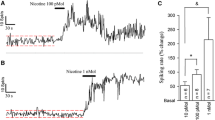Summary.
We studied sequential changes in muscarinic cholinergic receptors, high-affinity choline uptake sites and dopamine D2 receptors in the brain after 6-hydroxydopamine lesions of the medial forebrain bundle in rats. The animals were unilaterally lesioned in the medial forebrain bundle and the brains were analyzed at 1, 2, 4 and 8 weeks postlesion. [3H]Quinuclidinylbenzilate (QNB), [3H]hemicholinum-3 (HC-3) and [3H]raclopride were used to label muscarinic cholinergic receptors, high-affinity choline uptake sites and dopamine D2 receptors, respectively. The degeneration of nigrostriatal pathway produced a transient decrease in [3H]QNB binding in the parietal cortex of both ipislateral and contralateral sides at 2 and 8 weeks postlesion. [3H] QNB binding also showed a mild but insignificant decrease in the ipsilateral striatum throughout the postlesion periods. No significant change was observed in the substantia nigra (SN) of both ipsilateral and contralateral sides throughout the postlesion periods. In contrast, [3H]HC-3 binding showed no significant change in the parietal cortex of both ipsilateral and contralateral sides during the postlesion. However, [3H]HC-3 binding was upregulated in the ipsilateral dorsolateral striatum throughout the postlesion periods. The ventromedial striatum also showed a significant increase in [3H]HC-3 binding at 1 week and 2 weeks postlesion. On the other hand, no significant change in [3H]raclopride binding was found in the parietal cortex of both ipsilateral and contralateral sides during the postlesion. [3H]Raclopride binding showed a conspicuous increase in the ipsilateral striatum (35–52% of the sham-operated values in the lateral part and 39–54% in the medial part) throughout the postlesion periods. In the contralateral side, a mild increase in [3H]raclopride binding was also found in the striatum (10–15% of the sham-operated values in the lateral part and 22% in the medial part) after lesioning. However, a significant decline in [3H]raclopride binding was observed in the ipsilateral SN and ventral tegmental area during the postlesion.
The present study indicates that 6-hydroxydopamine injection of medial forebrain bundle in rats can cause functional changes in high-affinity choline uptake site in the striatum, as compared with muscarinic cholinergic receptors. Furthermore, our studies demonstrate an upregulation in dopamine D2 receptors in the striatum and a decrease in the receptors in the SN and ventral tegmental area after the 6-hydroxydopamine injection. Thus, these findings provide further support for neurodegeneration of the nigrostriatal pathway that occurs in Parkinson's disease.
Similar content being viewed by others
Author information
Authors and Affiliations
Additional information
Received April 26, 1999; accepted November 12, 1999
Rights and permissions
About this article
Cite this article
Araki, T., Tanji, H., Fujihara, K. et al. Sequential changes of cholinergic and dopaminergic receptors in brains after 6-hydroxydopamine lesions of the medial forebrain bundle in rats. J Neural Transm 107, 873–884 (2000). https://doi.org/10.1007/s007020070039
Issue Date:
DOI: https://doi.org/10.1007/s007020070039




